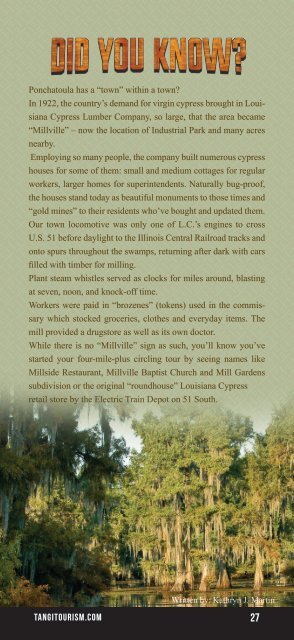Visitor Guide 4x9 2017 final 1-11
Create successful ePaper yourself
Turn your PDF publications into a flip-book with our unique Google optimized e-Paper software.
Ponchatoula has a “town” within a town?<br />
In 1922, the country’s demand for virgin cypress brought in Louisiana<br />
Cypress Lumber Company, so large, that the area became<br />
“Millville” – now the location of Industrial Park and many acres<br />
nearby.<br />
Employing so many people, the company built numerous cypress<br />
houses for some of them: small and medium cottages for regular<br />
workers, larger homes for superintendents. Naturally bug-proof,<br />
the houses stand today as beautiful monuments to those times and<br />
“gold mines” to their residents who’ve bought and updated them.<br />
Our town locomotive was only one of L.C.’s engines to cross<br />
U.S. 51 before daylight to the Illinois Central Railroad tracks and<br />
onto spurs throughout the swamps, returning after dark with cars<br />
filled with timber for milling.<br />
Plant steam whistles served as clocks for miles around, blasting<br />
at seven, noon, and knock-off time.<br />
Workers were paid in “brozenes” (tokens) used in the commissary<br />
which stocked groceries, clothes and everyday items. The<br />
mill provided a drugstore as well as its own doctor.<br />
While there is no “Millville” sign as such, you’ll know you’ve<br />
started your four-mile-plus circling tour by seeing names like<br />
Millside Restaurant, Millville Baptist Church and Mill Gardens<br />
subdivision or the original “roundhouse” Louisiana Cypress<br />
retail store by the Electric Train Depot on 51 South.<br />
Written by: Kathryn J. Martin<br />
tangitourism.com<br />
27









